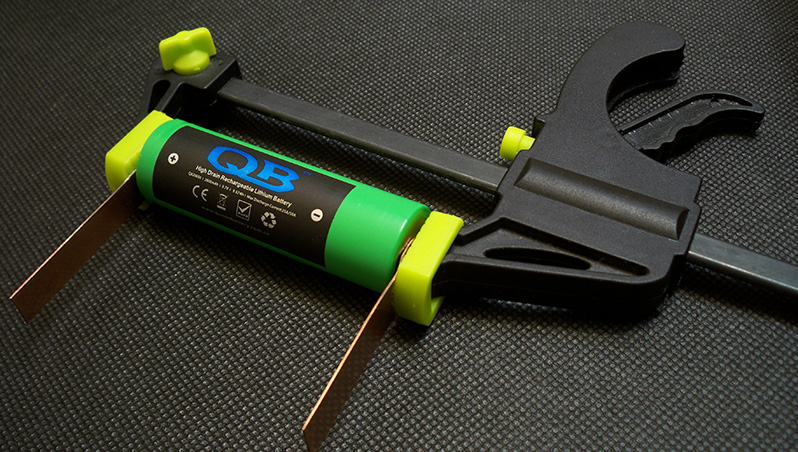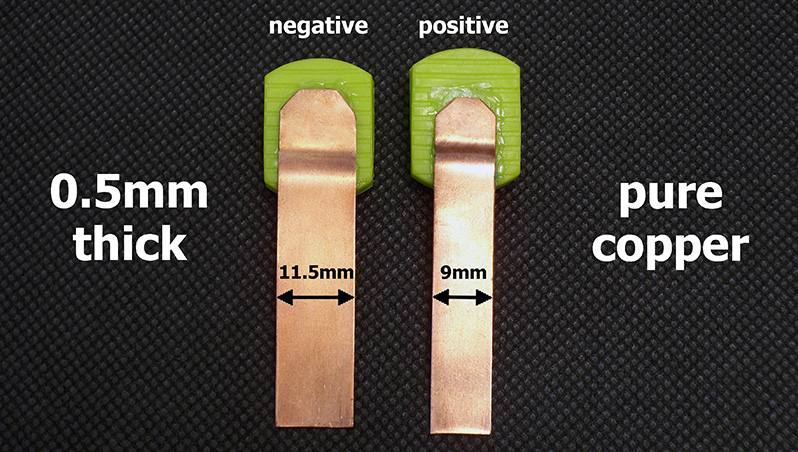thunderheart
Member
- Joined
- Apr 4, 2018
- Messages
- 276
Samsung ICR18650-26J is a 2600mAh Li-ion cell of 18650 size which supports continuous discharge at up to 5.2A.

The battery was bought from my reliable supplier (Queen Battery) and tested withZKETECH EBC-A20and a self-made battery holder. It's a PC-connected battery tester supporting 4-wire measuring and discharging at up to 20A.

I've used version 3.0 of my battery holder based on 0.5mm thick pure copper terminals


I've followed all the prescriptions of theIEC61960-2003standard concerning battery's capacity measurement. Before each discharging cycle each battery was charged at standard charge current mentioned in its datasheet to charge end voltage. Before each discharging or charging i've held a 1-1.5hrs pause. The environment temperature was 23.0-24.5C. To be sure in results i've done each testminimum twice(usually 3-4 times).
Samsung ICR18650-26J
The cell is marked as ICR18650-26J M SAMSUNG SDIEM THR2 which means that the production date is 02 Apr 2017.

The main specs from Samsung 26Jdatasheet:
Nominal capacity:2600mAh
Minimum capacity:2550mAh
Nominal voltage:3.63V
Standard charge current:1.3A (0.5C)
Maximum charge current:2.6A (1C)
Charge cut-off current:0.13A (0.05C)
Charge end voltage:4.20V
Max. continuous discharge current:5.2A (2C)
Discharge cut-off voltage:2.75V
AC impedance at 1KHz:?100m?
Max weight:45g
Cycle life:
After 300 cycles using 1.3A charge / 1.3A discharge the capacity measured at 0.2C discharge should be ?1785mAh (70% of initial minimum capacity).
DC IR at 2.6A in fully charged condition was 42.32.7m? (measured using EB Tester Software's Resistance test feature).
Measured dimensions: 18.3mm (diameter) 65.0mm (length).
Measured weight: 43.87g.

Capacity test results:

At 0.2C/0.52A the capacity was a very little bit higher than 2600mAh declared. At 2A and 5A discharge it was around 2450mAh. The curves look excellent.
Samsung limits the charge cut-off current by 0.05C instead of more common 0,02C and the discharge cut-off voltage by 2.75V instead of 2.5V. With 0.02C and 2.5V the results would be better but i think Samsung is worried about cycle life of this cell - 70% of initial capacity after 300 cycles 0.5C charge / 0.5C discharge doesn't make me cry wow. Whatever, real-world cycle life could differ.
Samsung 26J is a good low-drain medium capacity 18650 cell without any special features. The price (somewhere around/below $2) makes it an excellent choice for large battery packs.
Here is the video version of this review:

Check outmyYouTube channelfor batteries, chargers and other stuff reviews.
I've launchedmy blogwhere you can find all my reviews in one place. Every new test/review will be first published on YouTube and in the blog. I'll be happy to see new subscribers, comments, suggestions and just your thoughts.

The battery was bought from my reliable supplier (Queen Battery) and tested withZKETECH EBC-A20and a self-made battery holder. It's a PC-connected battery tester supporting 4-wire measuring and discharging at up to 20A.

I've used version 3.0 of my battery holder based on 0.5mm thick pure copper terminals


I've followed all the prescriptions of theIEC61960-2003standard concerning battery's capacity measurement. Before each discharging cycle each battery was charged at standard charge current mentioned in its datasheet to charge end voltage. Before each discharging or charging i've held a 1-1.5hrs pause. The environment temperature was 23.0-24.5C. To be sure in results i've done each testminimum twice(usually 3-4 times).
Samsung ICR18650-26J
The cell is marked as ICR18650-26J M SAMSUNG SDIEM THR2 which means that the production date is 02 Apr 2017.

The main specs from Samsung 26Jdatasheet:
Nominal capacity:2600mAh
Minimum capacity:2550mAh
Nominal voltage:3.63V
Standard charge current:1.3A (0.5C)
Maximum charge current:2.6A (1C)
Charge cut-off current:0.13A (0.05C)
Charge end voltage:4.20V
Max. continuous discharge current:5.2A (2C)
Discharge cut-off voltage:2.75V
AC impedance at 1KHz:?100m?
Max weight:45g
Cycle life:
After 300 cycles using 1.3A charge / 1.3A discharge the capacity measured at 0.2C discharge should be ?1785mAh (70% of initial minimum capacity).
DC IR at 2.6A in fully charged condition was 42.32.7m? (measured using EB Tester Software's Resistance test feature).
Measured dimensions: 18.3mm (diameter) 65.0mm (length).
Measured weight: 43.87g.

Capacity test results:

At 0.2C/0.52A the capacity was a very little bit higher than 2600mAh declared. At 2A and 5A discharge it was around 2450mAh. The curves look excellent.
Samsung limits the charge cut-off current by 0.05C instead of more common 0,02C and the discharge cut-off voltage by 2.75V instead of 2.5V. With 0.02C and 2.5V the results would be better but i think Samsung is worried about cycle life of this cell - 70% of initial capacity after 300 cycles 0.5C charge / 0.5C discharge doesn't make me cry wow. Whatever, real-world cycle life could differ.
Samsung 26J is a good low-drain medium capacity 18650 cell without any special features. The price (somewhere around/below $2) makes it an excellent choice for large battery packs.
Here is the video version of this review:

Check outmyYouTube channelfor batteries, chargers and other stuff reviews.
I've launchedmy blogwhere you can find all my reviews in one place. Every new test/review will be first published on YouTube and in the blog. I'll be happy to see new subscribers, comments, suggestions and just your thoughts.


